A Survey on Massive MIMO Systems in Presence of Channel and Hardware Impairments
Abstract
1. Introduction
Notations
2. Basic Concepts
2.1. Uplink Transmission
2.2. Downlink Transmission
3. Advantages and Challenges
3.1. Advantages
- High spectral efficiency: In massive MIMO, using large number of BS antennas and having aggressive spatial multiplexing gives the ability to the users to simultaneously use the same frequency band without interference. This increases the spectral efficiency of the system.
- High power efficiency: Since in massive MIMO we have large number of BS antennas, the energy can be concentrated in a small area and this increases the power efficiency. In these systems the users can reduce their transmit power as we increase the number of BS antennas, while being able to have a performance similar to the SISO case.
- High degree of freedom: Massive MIMO systems have high degree of freedom. For example if we have 200 antennas at the BS and 20 single antenna users, then we have 180 degree of freedom which can be used to help reduce the interference. In other words, we can design the transmitted signals from the BS antennas in a way that all these signals are added constructively at the users and destructively almost anywhere else.
- Enabling reduction of latency: Fading limits the performance of wireless communications systems and makes building low latency links hard. When a user experiences a fading dip it has to wait for suitable change of the channel before receiving the data. However, massive MIMO systems avoid fading dip by having large number of BS antennas and, therefore, enable reduction of latency.
3.2. Challenges
- Antenna array design: Configuration and orientation of antenna arrays in massive MIMO systems is a problem which needs further studies. For example it should be investigated whether 2 dimensional or 3 dimensional antennas are suitable. Also having centralized or distributed antenna arrays and the distance between the antennas and the mutual coupling effect should be studied.
- Implementation in FDD mode: The performance of massive MIMO systems is very dependent on the channel knowledge at the BS. In the uplink the users send orthogonal pilots and the BS estimates the channel of each user considering the pilots. In the downlink of conventional MIMO systems, the BS sends pilots to the users and the users feedback the channel information to the BS, after estimating it. However, since the number of resources needed for channel estimation is proportional to the number of antennas at the transmitter, estimating the channel in downlink of massive MIMO systems where we have large number of antennas at the BS is not suitable and it requires many resources. Also in these systems, the number of channels which each user has to estimate is large and, therefore, a large amount of information has to be fed back to the BS. One solution is to use time division duplex (TDD) mode and take advantage of channel reciprocity to estimate the downlink channel in the uplink. However, this mode also has some drawbacks, for example the hardware impairments in the BS and user side may affect channel reciprocity, not to mention possible channel variations between the time it is estimated and the time it is used (i.e., channel aging effects). Also many current systems work with FDD mode, and for massive MIMO to be compatible with these systems we need to be able to implement it in FDD mode. So, implementing massive MIMO in FDD mode with low training and feedback overhead is an issue that needs further studies.
- Pilot contamination: In TDD mode, each user sends an orthogonal pilot for channel estimation. Since the coherence time of channel is limited, there is a limited number of orthogonal pilots and therefore users in other cells have to reuse these pilots. So, the estimated channel of a specific user will be contaminated with a linear combination of the channel of other users which use the same pilot. Since the beamforming is done considering these estimated channels, an interference between users who use the same pilot will occur.
- Channel model: Most of the works on massive MIMO systems are done with the assumption of time invariant flat rayleigh fading channels. Since in OFDM systems the channel over each sub-carrier is considered flat, the studies on flat fading channels can be extended to OFDM systems. However, in many practical scenarios, the channel is frequency selective and time variant. The channel coefficients can also have different distributions. So, studying these systems in more realistic environments is an issue which needs further investigations.
- Waveform: In 5G, to reach the required data rate and latency expected for future wireless communications the structure of the wireless communication needs significant changes. In other words, 5G is not a simple extension of 4G and it should use some new technologies and integrate different wireless access technologies [23]. Massive MIMO is one of these technologies. In each of these technologies the suitable waveform in different scenarios has to be investigated. Although in 2016 3GPP decided to study various features of 5G new radio (NR) assuming OFDM, but this can change if significant gains can be demonstrated by any other waveform [24,25,26]. Some of the reasons that OFDM is selected for NR uplink and downlink are [27]
- -
- OFDM is a scalable waveform with low implementation complexity,
- -
- Compatibility with multi-antenna technologies,
- -
- High spectral efficiency.
However, OFDM has some drawbacks such as lower frequency localization and high PAPR. Therefore, although an early decision was taken to use the OFDM as 5G waveform, the exact waveform has not yet been decided and other waveforms such as SC-FDMA (also denoted DFT spread OFDM) are also being investigated [24]. - Hardware impairments: Since in massive MIMO systems we have large numbers of antennas, we need to use low-cost hardware to have a cost effective system. This means that hardware impairments will appear, which affect the performance of the system. Therefore, analyzing the performance of massive MIMO systems in presence of hardware impairments and proposing low complexity techniques for compensating them is crucial.
4. Waveform Selection
4.1. Candidate Waveforms
4.1.1. OFDM
4.1.2. OFDMA
4.1.3. SC-FDP
4.1.4. SC-FDMA
4.2. Studies on Multi-Carrier Waveforms
4.3. Studies on Single Carrier Waveforms
5. Hardware Impairments
5.1. Carrier Frequency Offset (CFO)
5.2. Power Amplifier Distortion (PAD)
5.3. I/Q Imbalance
5.4. Phase Noise
6. Time Varying Channels
6.1. Time Varying Flat Fading Channels
6.2. Time Varying Frequency Selective Channels
7. Conclusions
Author Contributions
Funding
Conflicts of Interest
References
- Gong, S.; Karlsson, M. Pushing the Wireless Data Rate to the Internet Speed. IEEE Access 2016, 4, 8787–8792. [Google Scholar] [CrossRef]
- Swindlehurst, A.L.; Ayanoglu, E.; Heydari, P.; Capolino, F. Millimeter-wave massive MIMO: The next wireless revolution? IEEE Commun. Mag. 2014, 52, 56–62. [Google Scholar] [CrossRef]
- Yang, Y.; Bai, B.; Chen, W. Achieving high frequency reuse in dense cellular networks: A matrix graph approach. In Proceedings of the 2014 IEEE Global Conference on Signal and Information Processing (GlobalSIP), Atlanta, GA, USA, 3–5 December 2014. [Google Scholar]
- Karjalainen, J.; Nekovee, M.; Benn, H.; Kim, W.; Park, J.; Sungsoo, H. Challenges and Opportunities of mm-Wave Communication in 5G Networks. In Proceedings of the 2014 9th International Conference on Cognitive Radio Oriented Wireless Networks and Communications (CROWNCOM), Oulu, Finland, 2–4 June 2014; pp. 372–376. [Google Scholar]
- Lu, L.; Li, G.; Swindlehurst, A.L.; Ashikhmin, A.; Zhang, R. An Overview of Massive MIMO: Benefits and Challenges. IEEE J. Sel. Top. Signal Process. 2014, 8, 742–758. [Google Scholar] [CrossRef]
- Grundinger, A.; Joham, M.; Utschick, W. Stochastic transceiver design in point-to-point MIMO channels with imperfect CSI. In Proceedings of the 2011 International ITG Workshop on Smart Antennas, Aachen, Germany, 24–25 February 2011. [Google Scholar]
- Larsson, E.G.; Edfors, O.; Tufvesson, F.; Marzetta, T.L. Massive MIMO for Next Generation Wireless Systems. IEEE Commun. Mag. 2014, 52, 186–195. [Google Scholar] [CrossRef]
- Marzetta, T.L. Noncooperative cellular wireless with unlimited numbers of base station antennas. IEEE Trans. Wirel. Commun. 2010, 9, 3590–3600. [Google Scholar] [CrossRef]
- Ciuonzo, D.; Rossi, P.S.; Dey, S. Massive MIMO channel aware decision fusion. IEEE Trans. Signal Process. 2015, 63, 604–619. [Google Scholar] [CrossRef]
- Shirazinia, A.; Dey, S.; Ciuonzo, D.; Rossi, P.S. Massive MIMO for Decentralized Estimation of a Correlated Source. IEEE Trans. Signal Process. 2016, 64, 2499–2512. [Google Scholar] [CrossRef]
- Jiang, F.; Chen, J.; Swindlehurst, A.L.; Lopez-Salcedo, J.A. Massive MIMO for Wireless Sensing with a Coherent Multiple Access Channel. IEEE Trans. Signal Process. 2015, 63, 3005–3017. [Google Scholar] [CrossRef]
- Ciuonzo, D.; Rossi, P.S.; Dey, S. Massive MIMO meets decision fusion: Decode and fuse vs. decode then fuse. In Proceedings of the 2014 IEEE 8th Sensor Array and Multichannel Signal Processing Workshop (SAM), A Coruna, Spain, 22–25 June 2014. [Google Scholar]
- Ding, G.; Gao, X.; Xue, Z.; Wu, Y.; Shi, Q. Massive MIMO for distributed detection with transceiver impairments. IEEE Trans. Veh. Technol. 2018, 67, 604–617. [Google Scholar] [CrossRef]
- Boccardi, F.; Heath, R.W.; Lozano, A.; Marzetta, T.L.; Popovski, P. Five Disruptive Technology Directions for 5G. IEEE Commun. Mag. 2014, 52, 74–80. [Google Scholar] [CrossRef]
- Shafi, M.; Molisch, A.F.; Smith, P.J.; Haustein, T.; Zhu, P.; De Silva, P.; Tufvesson, F.; Benjebbour, A.; Wunder, G. 5G: A Tutorial Overview of Standards, Trials, Challenges, Deployment, and Practice. IEEE J. Sel. Areas Commun. 2017, 35, 1201–1221. [Google Scholar] [CrossRef]
- Banelli, P.; Buzzi, S.; Colavolpe, G.; Modenini, A.; Rusek, F.; Ugolini, A. Modulation Formats and Waveforms for 5G Networks: Who Will Be the Heir of OFDM?: An overview of alternative modulation schemes for improved spectral efficiency. IEEE Signal Process Mag. 2014, 31, 80–93. [Google Scholar] [CrossRef]
- Zheng, K.; Zhao, L.; Mei, J.; Shao, B.; Xiang, W.; Hanzo, L. Survey of Large-Scale MIMO Systems. IEEE Commun. Surv. Tutor. 2015, 17, 1738–1760. [Google Scholar] [CrossRef]
- Yang, S.; Hanzo, L. Fifty Years of MIMO Detection: The Road to Large-Scale MIMOs. IEEE Commun. Surv. Tutor. 2015, 17, 1941–1988. [Google Scholar] [CrossRef]
- Fatema, N.; Hua, G.; Xiang, Y.; Peng, D.; Natgunanathan, I. Massive MIMO Linear Precoding: A Survey. IEEE Syst. J. 2018, 122, 3920–3931. [Google Scholar] [CrossRef]
- Elijah, O.; Leow, C.Y.; Abdul Rahman, T.; Nunoo, S.; Iliya, S.Z. A Comprehensive Survey of Pilot Contamination in Massive MIMO—5G System. IEEE Commun. Surv. Tutor. 2016, 18, 905–923. [Google Scholar] [CrossRef]
- Björnson, E.; Larsson, E.G.; Marzetta, T.L. Massive MIMO: Ten Myths and One Critical Question. IEEE Commun. Mag. 2016, 54, 114–123. [Google Scholar] [CrossRef]
- Ngo, H.Q.; Larsson, E.G.; Marzetta, T.L. Energy and Spectral Efficiency of Very Large Multiuser MIMO Systems. IEEE Trans. Commun. 2013, 61, 1436–1449. [Google Scholar]
- Ruffini, M. Multidimensional convergence in future 5G networks. J. Lightw. Technol. 2017, 35, 535–549. [Google Scholar] [CrossRef]
- Zaidi, A.A.; Baldemair, R.; Tullberg, H.; Björkegren, H.; Sundström, L.; Medbo, J.; Kilinc, C.; Silva, I.D. Waveform and numerology to support 5G services and requirements. IEEE Commun. Mag. 2016, 54, 90–98. [Google Scholar] [CrossRef]
- The 3rd Generation Partnership Project. 5G; Study on New Radio (NR) Access Technology; 3GPP. Tech. Report 38.913; 3GPP: Sophia Antipolis, France, 2016. [Google Scholar]
- Kavanagh, S. What is 5G New Radio (5G NR). Available online: https://5g.co.uk/guides/what-is-5g-new-radio/ (accessed on 9 July 2018).
- Zaidi, A.A.; Baldemair, R. In the Race to 5G, CP-OFDM Triumphs! Available online: https://www.ericsson.com/research-blog/in-race-to-5g-cp-ofdm-triumphs/ (accessed on 9 July 2018).
- Aminjavaheri, A.; Farhang, A.; Farhang-Boroujeny, B. Filter Bank Multicarrier in Massive MIMO: Analysis and Channel Equalization. IEEE Trans. Signal Process. 2018, 66, 3987–4000. [Google Scholar] [CrossRef]
- Michailow, N.; Matthé, M.; Gaspar, I.S.; Caldevilla, A.N.; Mendes, L.L.; Festag, A.; Fettweis, G. Generalized Frequency Division Multiplexing for 5th Generation Cellular Networks. IEEE Trans. Commun. 2014, 62, 3045–3061. [Google Scholar] [CrossRef]
- Pitarokoilis, A.; Mohammed, S.K.; Larsson, E.G. On the Optimality of Single-Carrier Transmission in Large-Scale Antenna Systems. IEEE Wirel. Commun. Lett. 2012, 1, 276–279. [Google Scholar] [CrossRef]
- Björnson, E.; Larsson, E.G.; Debbah, M. Massive MIMO for Maximal Spectral Efficiency: How Many Users and Pilots Should Be Allocated? IEEE Trans. Wirel. Commun. 2016, 15, 1293–1308. [Google Scholar] [CrossRef]
- Yang, H.; Marzetta, T.L. Performance of conjugate and zero-forcing beamforming in large-scale antenna systems. IEEE J. Sel. Areas Commun. 2013, 31, 172–179. [Google Scholar] [CrossRef]
- Jose, J.; Ashikhmin, A.; Marzetta, T.L.; Vishwanath, S. Pilot contamination and precoding in multi-cell TDD systems. IEEE Trans. Wirel. Commun. 2011, 10, 2640–2651. [Google Scholar] [CrossRef]
- Ngo, H.Q.; Matthaiou, M.; Larsson, E.G. Massive MIMO with Optimal Power and Training Duration Allocation. IEEE Wirel. Commun. Lett. 2014, 3, 605–608. [Google Scholar] [CrossRef]
- Zhang, Q.; Jin, S.; McKay, M.; Morales-Jimenez, D.; Zhu, H. Power Allocation Schemes for Multicell Massive MIMO Systems. IEEE Trans. Wirel. Commun. 2015, 14, 5941–5955. [Google Scholar] [CrossRef]
- Torres, P.; Charrua, L.; Gusmao, A. On the SC/FDE Uplink Alternative to OFDM in a Massive MU-MIMO Context. In Proceedings of the The 10th IEEE International Conference on Wireless and Mobile Computing, Networking and Communications (WiMob 2014), Larnaca, Cyprus, 8–10 October 2014; pp. 26–31. [Google Scholar]
- Dinis, R.; Montezuma, P. An Iterative Receiver Based on the EGC for Massive MIMO Schemes using SC-FDE Modulations. Electron. Lett. 2016, 52, 972–974. [Google Scholar] [CrossRef]
- Torres, P.; Gusmao, A. Detection Issues with Many BS Antennas Available for Bandwidth-Efficient Uplink Transmission in a MU-MIMO System. In Proceedings of the 2016 IEEE Wireless Communications and Networking Conference, Doha, Qatar, 3–6 April 2016. [Google Scholar]
- Sun, Y.; Wang, J.; He, L.; Song, J. Spectral Efficiency Analysis for Spatial Modulation in Massive MIMO Uplink over Dispersive Channels. In Proceedings of the 2017 IEEE International Conference on Communications (ICC), Paris, France, 21–25 May 2017; pp. 1–6. [Google Scholar]
- Eshwaraiah, H.S.; Chockalingam, A. SC-FDMA for Multiuser Communication on the Downlink. In Proceedings of the 2013 Fifth International Conference on Communication Systems and Networks (COMSNETS), Bangalore, India, 7–10 January 2013; pp. 1–7. [Google Scholar]
- Cheng, H.V.; Larsson, E.G. Some Fundamental Limits on Frequency Synchronization in Massive MIMO. In Proceedings of the 2013 Asilomar Conference on Signals, Systems and Computers, Pacific Grove, CA, USA, 3–6 November 2013; pp. 1213–1217. [Google Scholar]
- Mukherjee, S.; Mohammed, S.K.; Bhushan, I. Impact of CFO Estimation on the Performance of ZF Receiver in Massive MU-MIMO Systems. IEEE Trans. Veh. Technol. 2016, 65, 9430–9436. [Google Scholar] [CrossRef]
- Ahmed-ouameur, M.; Massicotte, D.; Zhu, W. Carrier Frequency and Sampling Rate Offsets Effect on Sub 6 GHz Massive MIMO. In Proceedings of the 2015 Nordic Circuits and Systems Conference (NORCAS): NORCHIP & International Symposium on System-on-Chip (SoC), Oslo, Norway, 26–28 October 2015; pp. 1–4. [Google Scholar]
- Mukherjee, S.; Mohammed, S.K. Information-theoretic Performance of TR-MRC Receiver in Frequency-Selective Massive MU-MIMO Systems impaired by CFO. IEEE Wirel. Commun. Lett. 2016, 5, 648–651. [Google Scholar] [CrossRef]
- Mokhtari, Z.; Sabbaghian, M.; Dinis, R. Massive MIMO downlink based on single carrier frequency domain processing. IEEE Trans. Commun. 2018, 66, 1164–1175. [Google Scholar] [CrossRef]
- Mokhtari, Z.; Sabbaghian, M.; Dinis, R. Sum-rate of block-Wise SC massive MIMO systems in the presence of carrier frequency offset. In Proceedings of the 2017 IEEE 85th Vehicular Technology Conference (VTC Spring), Sydney, Australia, 4–7 June 2017; pp. 1–5. [Google Scholar]
- Mukherjee, S.; Mohammed, S.K. Low-Complexity CFO Estimation for Multi-User Massive MIMO Systems. Available online: http://arxiv.org/abs/1504.05657 (accessed on 11 September 2018).
- Zhang, W.; Gao, F. Blind Frequency Synchronization for Multiuser OFDM Uplink with Large Number of Receive Antennas. IEEE Trans. Signal Process. 2016, 64, 2255–2268. [Google Scholar] [CrossRef]
- Hojatian, H.; Saeedi-sourck, H.; Omidi, M.J.; Farhang, A. Joint CFO and Channel Estimation in OFDM-based Massive MIMO Systems. In Proceedings of the 2016 8th International Symposium on Telecommunications (IST), Tehran, Iran, 27–28 September 2016; pp. 343–348. [Google Scholar]
- Zhang, W.; Gao, F.; Jin, S.; Lin, H. Frequency Synchronization for Uplink Massive MIMO Systems. IEEE Trans. Wirel. Commun. 2018, 17, 235–249. [Google Scholar] [CrossRef]
- Mokhtari, Z.; Sabbaghian, M.; Eriksson, T. Iterative Channel and CFO Estimation for SC-FDE and OFDM based Massive MIMO Systems. In Proceedings of the 2019 IEEE 89th Vehicular Technology Conference, Kuala Lumpur, Malaysia, 28 April–1 May 2019. submitted. [Google Scholar]
- Tianjiu, L. Nonlinear characteristics and pre distortion modeling of a non memory RF power amplifier. In Proceedings of the 13th IEEE International Conference on Electronic Measurement & Instruments (ICEMI), Yangzhou, China, 20–22 October 2017. [Google Scholar]
- Saleh, A.; Adel, A. Frequency-Independent and Frequency-Dependent Nonlinear Models of TWT Amplifiers. IEEE Trans. Commun. 1981, 29, 1715–1720. [Google Scholar] [CrossRef]
- Ghorbani, A.; Sheikhan, M. The effect of solid state power amplifiers (SSPAs) nonlinearities on MPSK and M-QAM signal transmission. In Proceedings of the 1991 Sixth International Conference on Digital Processing of Signals in Communications, Loughborough, UK, 2–6 September 1991; pp. 193–197. [Google Scholar]
- Rapp, C. Effects of HPA-nonlinearity on 4-DPSK/OFDM-signal for a digital sound broadcasting system. In Proceedings of the 2nd European Conference on Satellite Communications, Liege, Belgium, 22–24 October 1991; pp. 179–184. [Google Scholar]
- Eltholth, A.A.; Mekhail, A.R.; Elshirbini, A.; Dessouki, M.I.; Abdelfattah, A.I. Modeling the Effect of Clipping and Power Amplifier Non-Linearities on OFDM Systems. Ubiquitous Comput. Commun. J. 2008, 3, 54–59. [Google Scholar]
- Sappal, A.S.; Patterh, M.S.; Sharma, S. Mathematical Modeling of Power Amplifier with Memory Effects. Indian J. Sci. Technol. 2009, 2, 22–23. [Google Scholar]
- Mohammed, S.K.; Larsson, E.G. Per-Antenna Constant Envelope Precoding for Large Multi-User MIMO Systems. IEEE Trans. Commun. 2013, 61, 1059–1071. [Google Scholar] [CrossRef]
- Mohammed, S.K.; Larsson, E.G. Constant-Envelope Multi-User Precoding for Frequency-Selective Massive MIMO Systems. IEEE Wirel. Commun. Lett. 2013, 2, 547–550. [Google Scholar] [CrossRef]
- Mollen, C. Low-PAR Precoding for Very-Large Multi-User MIMO Systems. Master’s Thesis, Linkoping University, Linköping, Sweden, 2013. [Google Scholar]
- Chen, J.; Wang, C.; Wong, K.; Wen, C. Low-Complexity Precoding Design for Massive Multiuser MIMO Systems Using Approximate Message Passing. IEEE Trans. Veh. Technol. 2016, 65, 5707–5714. [Google Scholar] [CrossRef]
- Studer, C.; Larsson, E.G. PAR-Aware Large-Scale Multi-User MIMO-OFDM Downlink. IEEE J. Sel. Areas Commun. 2013, 31, 303–313. [Google Scholar] [CrossRef]
- Prabhu, H.; Edfors, O.; Rodrigues, J.; Liu, L.; Rusek, F. A low-complex peak-to-average power reduction scheme for OFDM based massive MIMO systems. In Proceedings of the 2014 6th International Symposium on Communications, Control and Signal Processing (ISCCSP), Athens, Greece, 21–23 May 2014; pp. 114–117. [Google Scholar]
- Tarighat, A.; Sayed, A. MIMO OFDM Receivers for Systems with IQ Imbalances. IEEE Trans. Signal Process. 2005, 53, 3583–3596. [Google Scholar] [CrossRef]
- Anttila, L. Digital Front-End Signal Processing with Widely-Linear Signal Models in Radio Devices. Ph.D. Thesis, Tampere University of Technology, Tampere, Finland, October 2011. ISBN 978-952-15-2978-8. [Google Scholar]
- Zarei, S.; Gerstacker, W.; Schober, R. I/Q imbalance aware widely-linear precoding for downlink massive MIMO systems. In Proceedings of the 2014 IEEE Globecom Workshops (GC Wkshps), Austin, TX, USA, 8–12 December 2014; pp. 301–307. [Google Scholar]
- Kolomvakis, N.; Coldrey, M.; Eriksson, T.; Viberg, M. Massive MIMO Systems With IQ Imbalance: Channel Estimation and Sum Rate Limits. IEEE Trans. Commun. 2017, 65, 2382–2396. [Google Scholar] [CrossRef]
- Razavi, B. A Study of Phase Noise in CMOS Oscillators. IEEE J. Solid-St Circ. 1996, 31, 331–343. [Google Scholar] [CrossRef]
- Hajimiri, A.; Lee, T. A general theory of phase noise in electrical oscillators. IEEE J. Solid-State Circ.I. 1998, 33, 179–194. [Google Scholar] [CrossRef]
- Mukherjee, J. General Non Linear Perturbation Model of Phase Noise in LC Oscillators. Ph.D. Thesis, Ohio State University, Columbus, OH, USA, 2006. [Google Scholar]
- Baran, O.; Kasal, M. Oscillator phase noise models. In Proceedings of the 2008 18th International Conference Radioelektronika, Prague, Czech Republic, 24–25 April 2008. [Google Scholar]
- Pitarokoilis, A.; Mohammed, S.K.; Larsson, E.G. Uplink Performance of Time-Reversal MRC in Massive MIMO Systems Subject to Phase Noise. IEEE Trans. Wirel. Commun. 2015, 14, 711–723. [Google Scholar] [CrossRef]
- Corvaja, R.; Armada, A.G. Phase Noise Degradation in Massive MIMO Downlink with Zero-forcing and Maximum Ratio Transmission Pre-coding. IEEE Trans. Veh. Technol. 2016, 65, 8052–8059. [Google Scholar] [CrossRef]
- Khanzadi, M.R.; Durisi, G.; Eriksson, T. Capacity of SIMO and MISO Phase-Noise Channels with Common/Separate Oscillators. IEEE Trans. Commun. 2015, 63, 3218–3231. [Google Scholar] [CrossRef]
- Krishnan, R.; Khanzadi, M.R.; Krishnan, N.; Wu, Y.; Graelli Amat, A.; Eriksson, T.; Schober, R. Linear Massive MIMO Precoders in the Presence of Phase Noise—A Large-Scale Analysis. IEEE Trans. Veh. Technol. 2016, 65, 3057–3071. [Google Scholar] [CrossRef]
- Fan, P.; Zhao, J.; I, C. 5G high mobility wireless communications: challenges and solutions. China Commun. 2016, 13, 1–13. [Google Scholar] [CrossRef]
- The 3rd Generation Partnership Project. Study on Scenarios and Requirements for Next Generation Access Technologies; Tech. Report 38.913; 3GPP: Sophia Antipolis, France, 2016. [Google Scholar]
- Dankovics, T. Travel fast, stay connected with 5G! Available online: https://www.nokia.com/en_int/blog/travel-fast-stay-connected-5g (accessed on 4 July 2018).
- Truong, K.T.; Heath, R.W. Effects of channel aging in massive MIMO systems. J. Commun. Netw. 2013, 15, 338–351. [Google Scholar] [CrossRef]
- Papazafeiropoulos, A.; Ratnarajah, T. Linear precoding for downlink massive MIMO with delayed CSIT and channel prediction. In Proceedings of the IEEE Wireless Communications and Networking Conference (WCNC), Istanbul, Turkey, 6–9 April 2014; pp. 809–914. [Google Scholar]
- Bao, Q.; Wangy, H.; Chen, Y.; Liu, C. Downlink sum-rate and energy efficiency of massive MIMO systems with channel aging. In Proceedings of the 8th International Conference on Wireless Communications & Signal Processing (WCSP), Yangzhou, China, 13–15 October 2016; pp. 1–5. [Google Scholar]
- Chopra, R.; Murthy, C.R.; Suraweera, H.A.; Larsson, E.G. Performance analysis of FDD massive MIMO systems under channel aging. IEEE Trans. Wirel. Commun. 2018, 17, 1094–1108. [Google Scholar] [CrossRef]
- Guvensen, G.M.; Ayanoglu, E. Beamspace aware adaptive channel estimation for single-carrier time-varying massive MIMO channels. In Proceedings of the IEEE International Conference on Communications (ICC), Paris, France, 21–25 May 2017; pp. 1–7. [Google Scholar]
- Kashyap, S.; Mollen, C.; Emil, B.; Larsson, E.G. Performance analysis of (TDD) massive MIMO with kalman channel prediction. In Proceedings of the IEEE International Conference on Acoustics, Speech and Signal Processing (ICASSP), New Orleans, LA, USA, 5–9 March 2017; pp. 3554–3558. [Google Scholar]
- Mokhtari, Z.; Sabbaghian, M.; Dinis, R. Downlink Sum-Rates of SC-FDP and OFDM Massive MIMO Systems in Doubly Dispersive Channels. IEEE Trans. Veh. Technol. 2018. submitted. [Google Scholar]
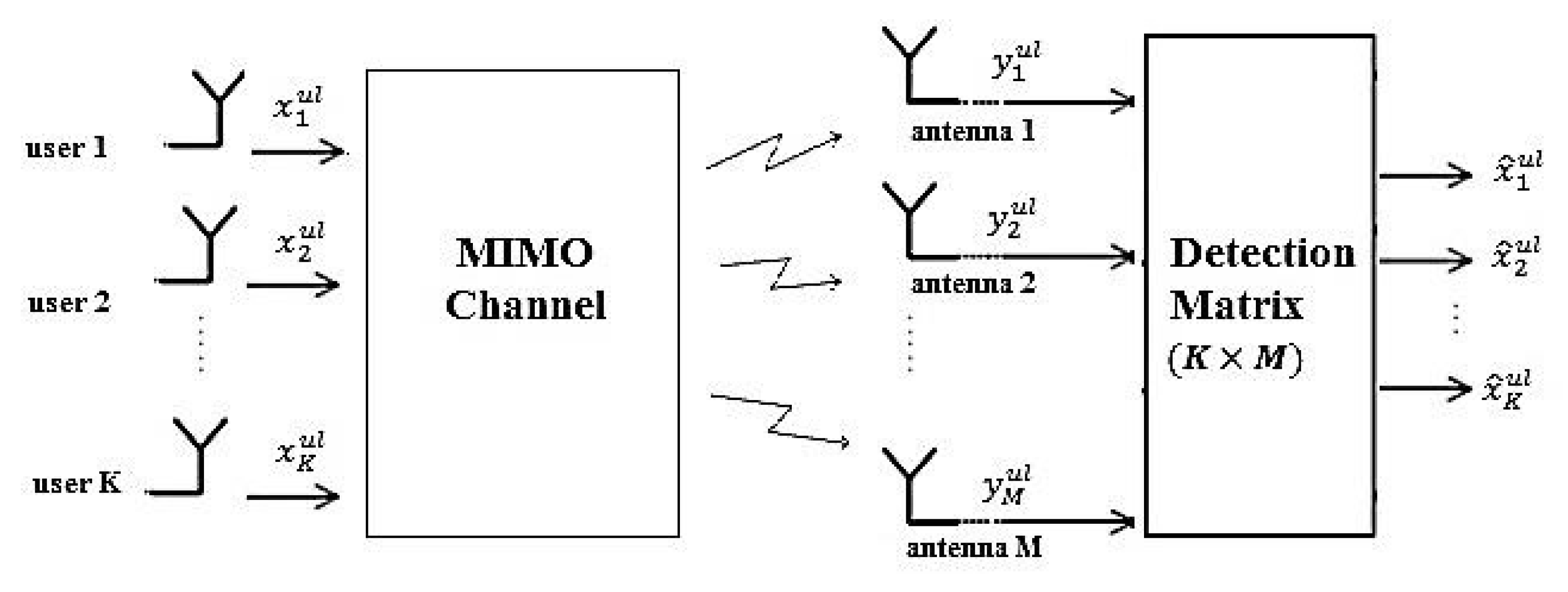
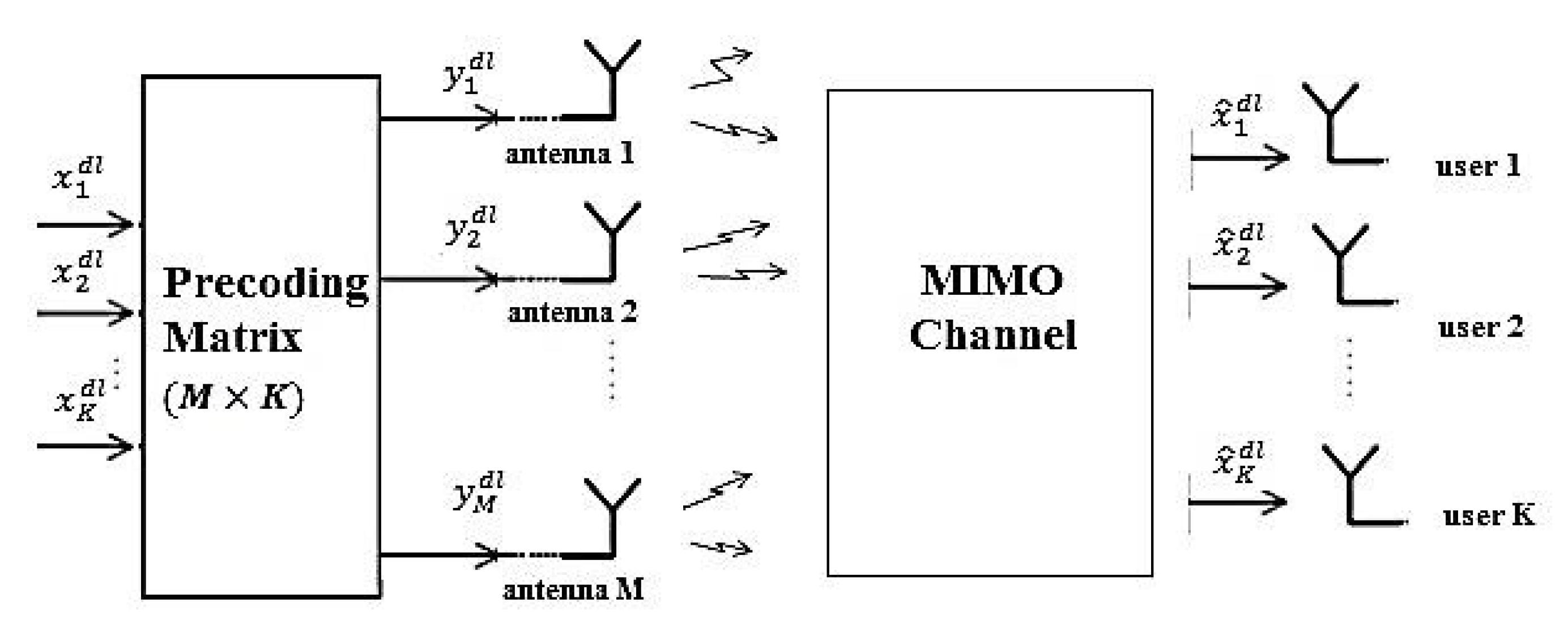

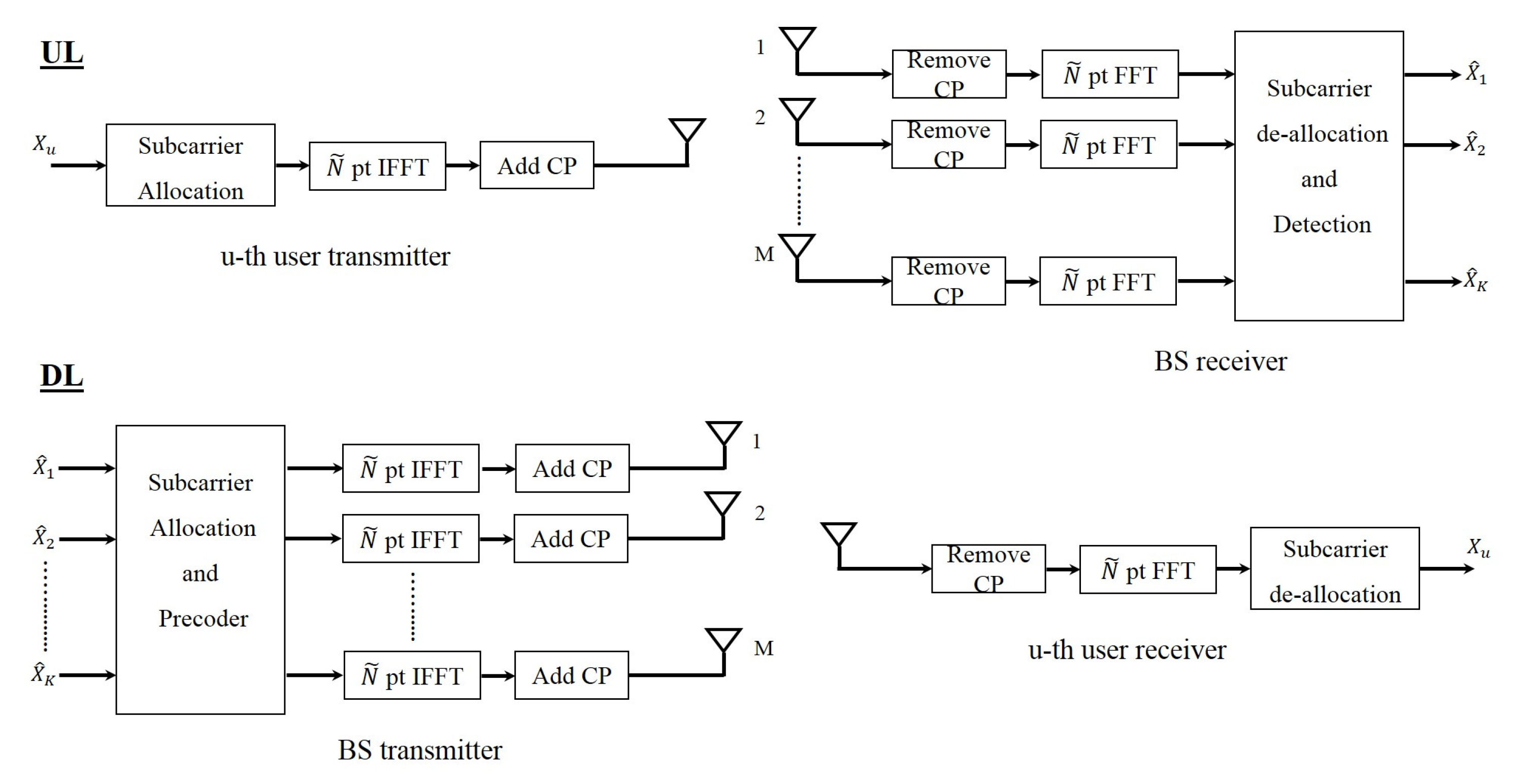
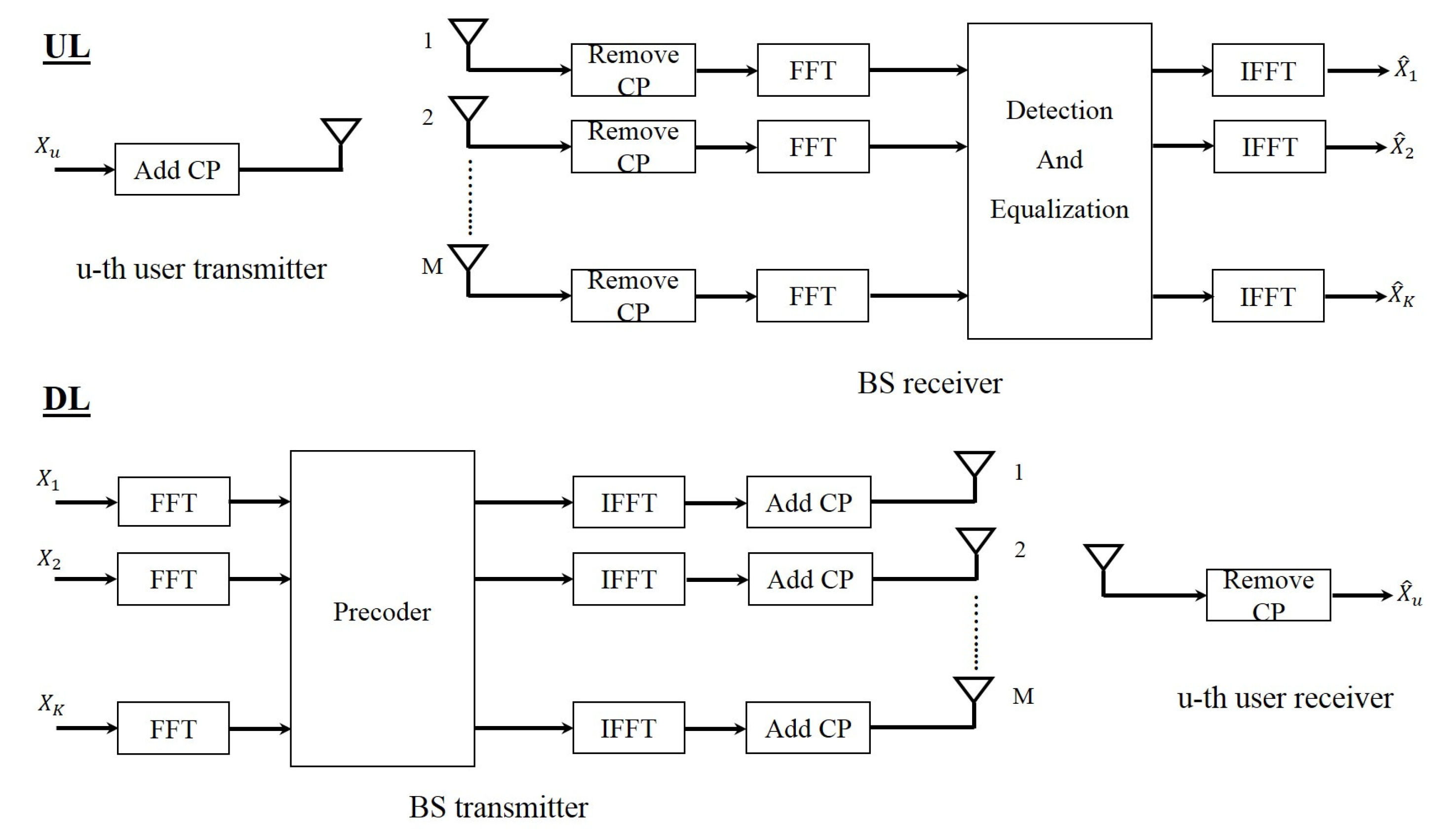
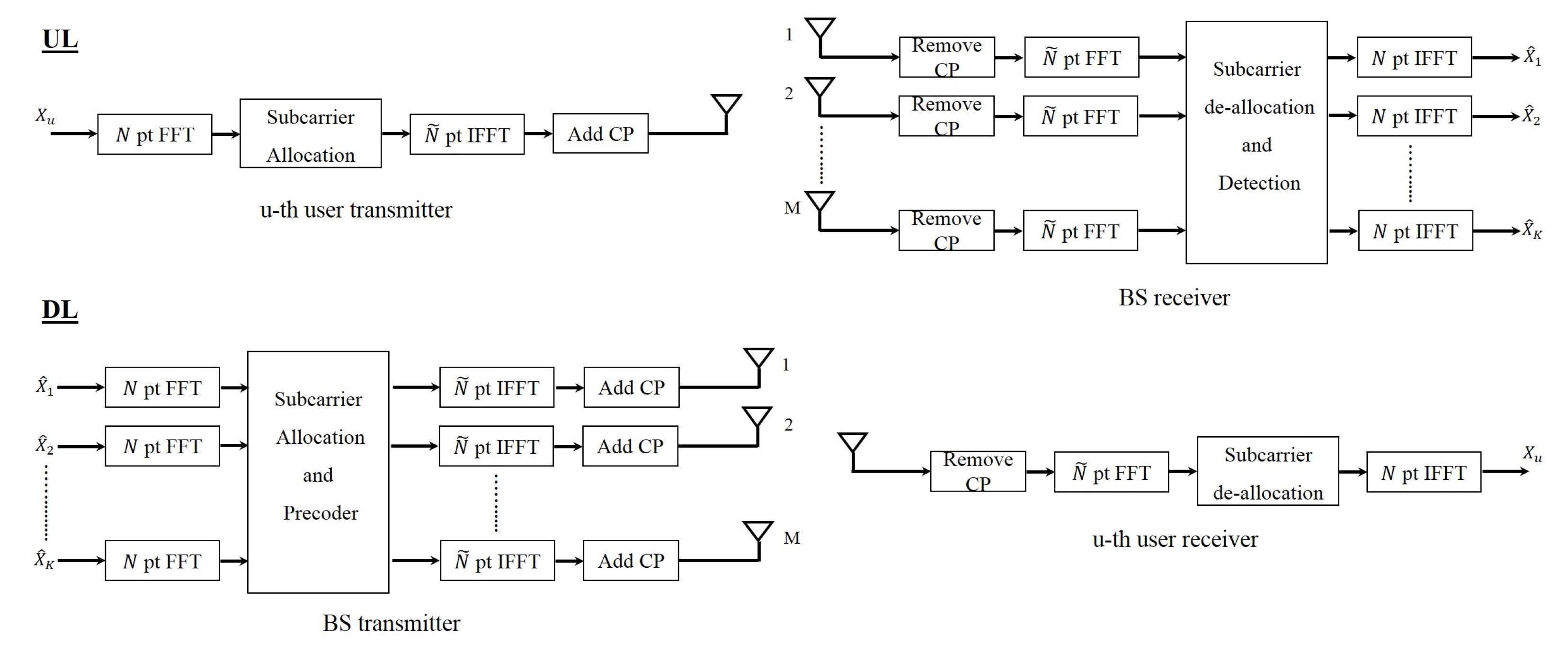


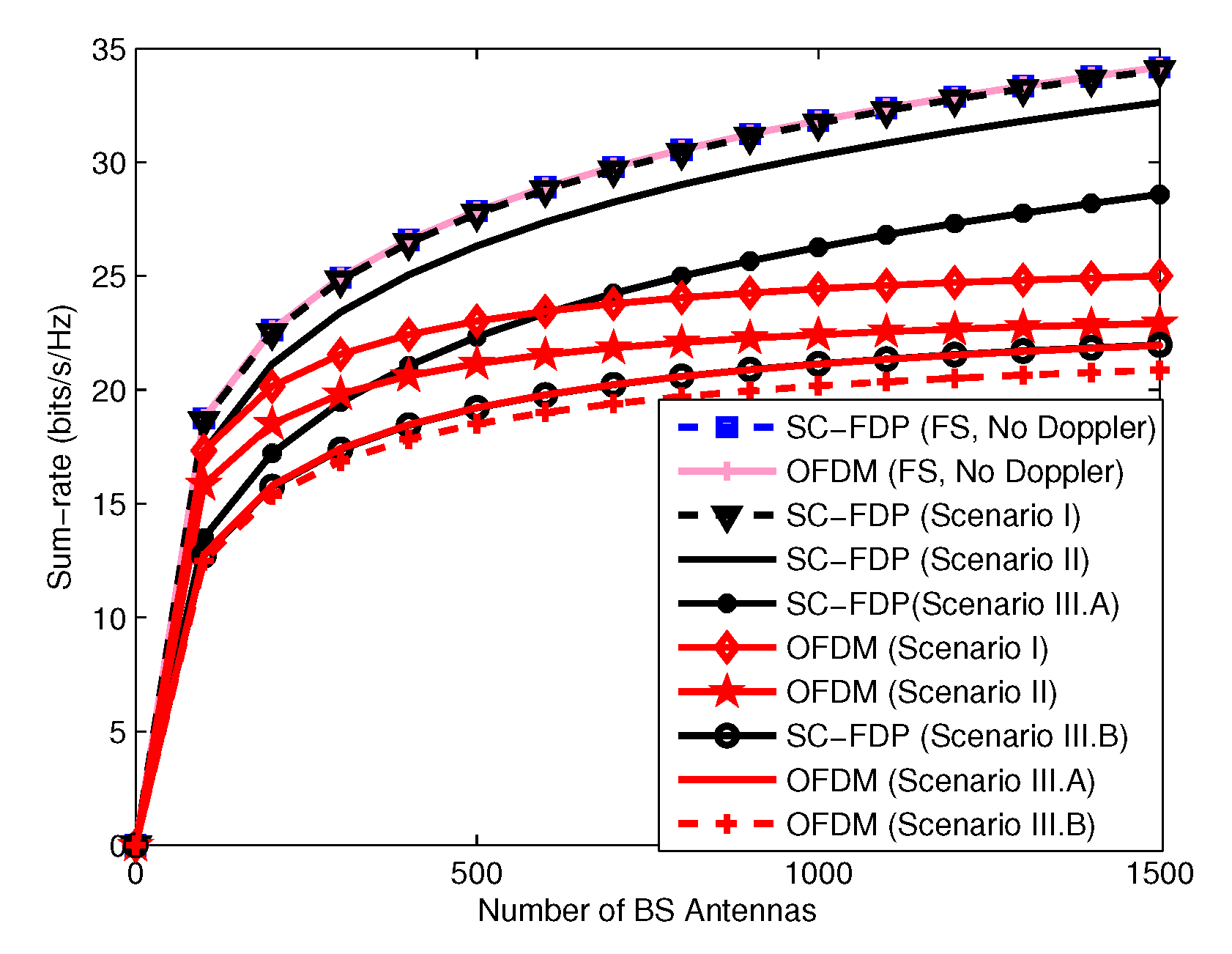
| Challenge | Paper |
|---|---|
| Waveform | [16] |
| Detection and Precoding | [18,19] |
| Hardware impairment | This survey |
| Channel measurement and modeling | [17] |
| Channel aging and time variation | This survey |
| Pilot contamination | [20] |
| Impairment | Effect | Possible Solution |
|---|---|---|
| CFO | - Performance degradation | - Using low complexity CFO estimation techniques |
| - Sum-rate limitation in the OFDM case | - Using less sensitive waveforms such as SC-FDP | |
| PAD | - Performance degradation | - Using Precoders that produce constant envelop signals |
| - Sum-rate limitation | - Using less sensitive waveforms such as SC-FDP | |
| - Out of band radiation | - Using clipping and system degree of freedom to compensate clipping distortion | |
| I/Q Imbalance | - Performance degradation | - Using Precoders that analyze real and imaginary parts separately |
| - Sum-rate limitation | ||
| - Inaccurate channel estimation | ||
| Phase noise | - Performance degradation | - Using more robust precoders |
| - Channel aging | - Using phase noise tracking techniques | |
| Channel Aging | - Performance degradation | - Using channel prediction techniques |
| - Sum-rate limitation in the OFDM case | - Using less sensitive waveforms such as SC-FDP |
© 2019 by the authors. Licensee MDPI, Basel, Switzerland. This article is an open access article distributed under the terms and conditions of the Creative Commons Attribution (CC BY) license (http://creativecommons.org/licenses/by/4.0/).
Share and Cite
Mokhtari, Z.; Sabbaghian, M.; Dinis, R. A Survey on Massive MIMO Systems in Presence of Channel and Hardware Impairments. Sensors 2019, 19, 164. https://doi.org/10.3390/s19010164
Mokhtari Z, Sabbaghian M, Dinis R. A Survey on Massive MIMO Systems in Presence of Channel and Hardware Impairments. Sensors. 2019; 19(1):164. https://doi.org/10.3390/s19010164
Chicago/Turabian StyleMokhtari, Zahra, Maryam Sabbaghian, and Rui Dinis. 2019. "A Survey on Massive MIMO Systems in Presence of Channel and Hardware Impairments" Sensors 19, no. 1: 164. https://doi.org/10.3390/s19010164
APA StyleMokhtari, Z., Sabbaghian, M., & Dinis, R. (2019). A Survey on Massive MIMO Systems in Presence of Channel and Hardware Impairments. Sensors, 19(1), 164. https://doi.org/10.3390/s19010164





